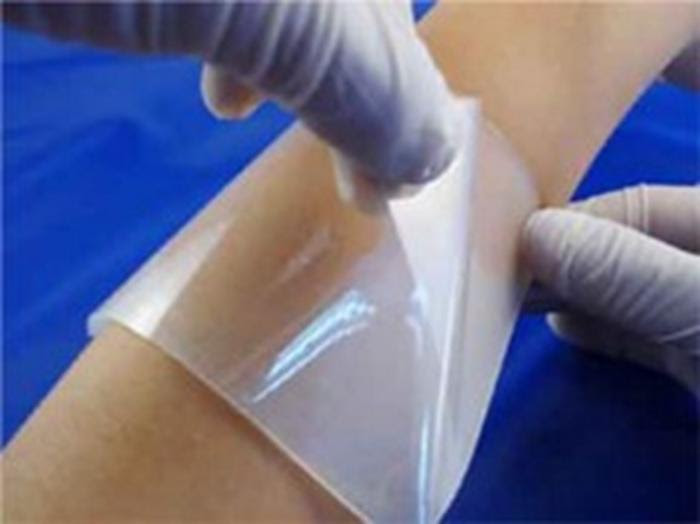By leveraging the power of oxygen, these gelatin patches can act as effective tissue adhesives that accelerate the healing of woundsPeer-Reviewed Publication
INCHEON NATIONAL UNIVERSITY
Hydrogels are a promising approach for treating wounds.

CONVENTIONAL WOUND MANAGEMENT TECHNIQUES LIKE SUTURE AND STAPLING HAVE SEVERAL DRAWBACKS. TISSUE ADHESIVE PATCHES MADE FROM HYDROGELS COULD BE A GOOD ALTERNATIVE SOLUTION TO ACCELERATE THE WOUND HEALING PROCESS, SINCE THEY CAN BE FUNCTIONALIZED WITH HEALING AGENTS AND THEIR MECHANICAL PROPERTIES CAN BE FINE-TUNED.
CREDIT: QEEKEN1 FROM OPENVERSE (HTTPS://OPENVERSE.ORG/IMAGE/350EDEB5-78BE-42A7-A551-7DEDA082385D)
Open wounds, whether caused by accidents or from medical procedures like surgery, require proper management to speed up healing and prevent infections. While sutures and staples are common wound closure methods, they can cause secondary tissue injuries, potentially leaking fluids and gases and requiring anesthetics. Tissue adhesive glues are a more attractive alternative but often suffer from toxicity and weak adhesion.
Fortunately, tissue adhesive patches offer an innovative solution. They allow precise control of adhesion and mechanical properties through adjustable polymeric compositions. These patches can also deliver drugs directly to wounds, enhancing recovery. While existing adhesive patches containing catecholamines such as dopamine (DA) have shown promise, they face challenges due to slow oxidation and weak bonding with the polymer backbone.
Against this backdrop, a team of researchers from Korea, led by Associate Professor Kyung Min Park of Incheon National University set out to find an effective solution to these limitations. As reported in their latest study, which was published in Composites Part B: Engineering, they developed a new strategy to produce DA-containing tissue adhesive gelatin hydrogels. Their study was made available online on August 21, 2023, and was published in Volume 266 of the journal on November 1, 2023.
Their approach is centered around the addition of calcium peroxide (CaO2) as an ingredient when preparing the hydrogel solution, giving rise to gelatin-based oxygen-generating tissue adhesives (GOTs). This compound reacts easily with water to release molecular oxygen (O2), facilitating the oxidation of DA molecules, promoting DA polymerization and healing of the wound. “Oxygen is a critical metabolic substrate or signaling molecule in the body. In particular, hyperoxia, which essentially means high oxygen concentration, has been demonstrated to facilitate wound healing processes and tissue regeneration by promoting cell proliferation, blood vessel formation, and wound remodeling,” explains Dr. Park.
Additionally, the researchers conducted in vitro and in vivo experiments demonstrating that their GOTs improved coagulation, blood closure, and neovascularization. These GOTs, in addition to their oxygen generation, allowed for easy control of gelation and mechanical properties, providing strong tissue adhesion in the 15–38 kPa range.
Remarkably, these GOTs represent the first reported bioadhesive, and the first tissue adhesive material for that matter, that can generate oxygen. The research team has high hopes for the potential of the GOTs to become a cost-effective solution for wound management in a clinical setting. “We would like to pursue clinical trials and commercialization of this material through follow-up research and ultimately contribute to improving the quality of human life by developing next-generation tissue adhesive materials that can be applied to humans,” concludes Dr. Park.
Reference
DOI: https://doi.org/10.1016/j.compositesb.2023.110951
About Incheon National University
Incheon National University (INU) is a comprehensive, student-focused university. It was founded in 1979 and given university status in 1988. One of the largest universities in South Korea, it houses nearly 14,000 students and 500 faculty members. In 2010, INU merged with Incheon City College to expand capacity and open more curricula. With its commitment to academic excellence and an unrelenting devotion to innovative research, INU offers its students real-world internship experiences. INU not only focuses on studying and learning but also strives to provide a supportive environment for students to follow their passion, grow, and, as their slogan says, be INspired.
Website: http://www.inu.ac.kr/mbshome/mbs/inuengl/index.html
About the authors
Kyung Min Park is an Associate Professor of the Department of Bioengineering and Nano-bioengineering at Incheon National University (INU). He received a PhD at the Department of Molecular Science and Technology at Ajou University, Korea in 2012. Before joining INU, he completed his postdoctoral training at Sharon Gerecht’s Lab at the Johns Hopkins University. His group is developing advanced polymeric biomaterials for a wide range of biomedical applications, including tissue regeneration and drug delivery. They are also developing engineered tissue models for studying the biological mechanism underlying various diseases (such as cancer and atopic dermatitis) and screening newly developed drugs.
JOURNAL
Composites Part B Engineering
DOI
10.1016/j.compositesb.2023.110951
METHOD OF RESEARCH
Experimental study
SUBJECT OF RESEARCH
Human tissue samples
ARTICLE TITLE
Oxygen-generating tissue adhesives via CaO2-mediated oxygen generation and in situ catechol oxidation for wound management
ARTICLE PUBLICATION DATE
1-Nov-2023
COI STATEMENT

Leave a Reply